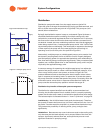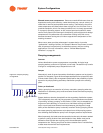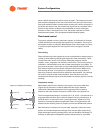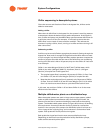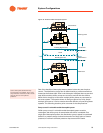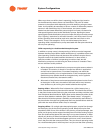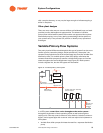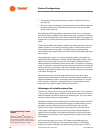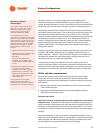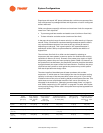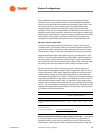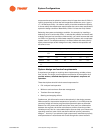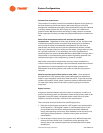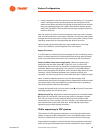
56 Chiller System Design and Control SYS-APM001-EN
System Configurations
• The bypass can be positioned either upstream or downstream of the
cooling coils.
• A control valve in the bypass ensures that the amount of flow through the
operating chiller(s) never falls below the minimum limit, but remains
closed most of the time.
Notice that the VPF design adds a modulating control valve in the bypass
line. At low loads, the bypass valve delivers the water necessary to maintain
the minimum evaporator-flow limit of each operating chiller. By contrast, the
bypass line in a primary-secondary system ensures constant chiller flow at all
times.
A less obvious difference between variable and constant primary flow lies in
system operation. In a primary-secondary system, a chiller and its primary
pump typically operate in tandem. The VPF design can separate pump
control (delivering enough water) from chiller sequencing (making the water
cold enough).
Like the secondary pump in a primary-secondary system, the pumps in a
typical VPF system operate to maintain a target differential pressure, P, a t a
specific point in the system (Figure 37). This pressure difference tends to
decrease when the air-handler control valves open in response to increasing
loads. To restore the P across the system, the pump controller increases the
speed of the pump. Conversely, when the air-handler control valves close in
response to decreased coil loads, the pump controller slows the pump speed
to maintain the target P.
Meanwhile, the plant controller stages the chillers on and off to match
cooling capacity with system load. If the air handlers operate properly, the
difference between the return- and supply-water temperatures, T, remains
nearly constant. Therefore, increasing the water flow through the chiller
evaporators increases the load on the operating chillers.
Advantages of variable primary flow
The desire to make or save money lies at the heart of many of our decisions.
In the context of HVAC design, decisions made to save money often involve a
trade-off between acquisition expense and operating cost. If you can realize
savings on both fronts, so much the better.
Perhaps this explains the increased interest in chilled water systems with VPF.
VPF designs use fewer pumps and fewer piping connections than primary–
secondary systems, which means fewer electrical lines and a smaller
footprint for the plant. These factors reduce the initial cost of the chilled-
water system, although the savings may be partially offset by additional
costs for flow-monitoring and bypass flow (bypass line and control valve).
VPF designs may also require more programming for system control than
other designs.
As for operating costs, how much a VPF design saves depends on the
pressure drops and efficiency of the pumps (see sidebar). A VPF design
displaces the small, inefficient, low-head primary pumps used in primary–
Operational savings of VPF
designs
Bahnfleth and Peyer
15
discuss the
operational savings of VPF designs. For
many common systems, however, the
primary pump power on which they base
their assessment may be too high.



